PAGE 89a – September 2009
H O T I D E A S F O R S M A L L R A I L R O A D S

Continuing our rummage through the editor’s files, we found several more excellent articles that didn’t quite fit into the themes of recent issues. They range from an N scale cog railway to several very tiny O scale standard-gauge lines. And the collection includes our very first Nano Layout, on an atomic-sized baseboard! Here they are… a gaggle of small layouts that can provide big inspiration and enjoyment.
In This Issue
Under Milk Wood—Classic Welsh NG layout is renewed
O Scale in 5 Feet!—Three excellent, very small layout designs
RIP Track Switching
A Double Keg of Coors
Two Capstans, No Waiting
The Smallest Micro—”Railroading” on an atomic scale!
Porth Byhan—A Cornish harbour in a boxfile
Brereton Heath—Boxfile holds a maintenance depot
Songøygard’s Sjokoladefabrikk—Hauling chocolates in Norway
October Lake—Gn15 shelf line beside a lake
Timpas, Colorado—AT&SF rolls on in Luxembourg
SprocketBahN—N scale working cog railway! Video proof!
CLASSIC WELSH NARROW-GAUGE LAYOUT RENEWED
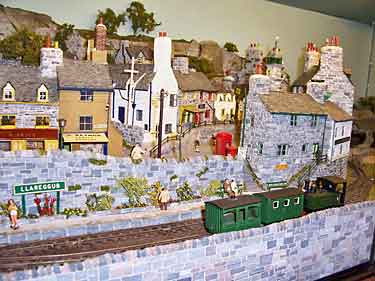
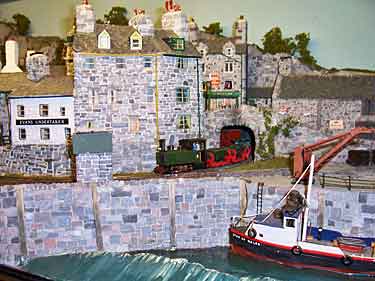
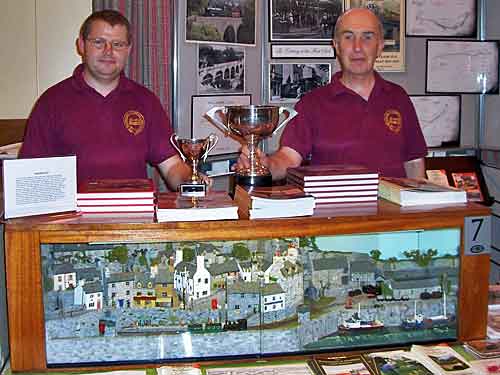
Under Milk Wood is a OO9 (4mm scale on 9mm gauge) layout set in the Welsh seaside town featured in Dylan Thomas’s poetic radio play of the same name. David Rowe built this detailed 4x2ft (120x60cm) layout in the early 1970s using settings from the play with structures based on Barmouth in Mid Wales.
Eventually David sold the layout to the Welsh Development Agency who used it to promote tourism. Then it was put into storage. John Forman (at right in this photo) is now restoring it. Gareth Houghton (at left) tours the long-lived layout on the exhibition circuit, where it has won several awards (these cups are from Loughborough Model Railway Exhibition in 2006). Gareth also took the photos.
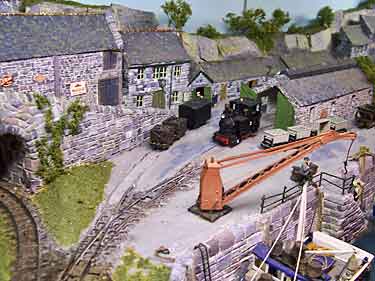
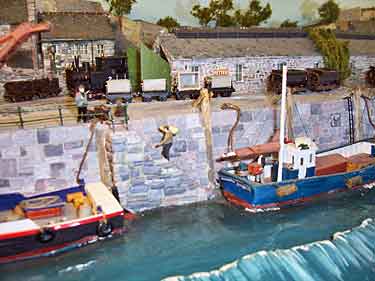
O STANDARD-GAUGE LAYOUT NO LONGER THAN 5ft (152cm)? IMPOSSIBLE?
A few months ago Prof Klyzlr, the Sydney Satrap and perpetrator of Brooklyn: 3 AM, posted a challenge on the Small Layout Design discussion group at Yahoo. He had been asked if he could build for an upcoming exhibition an O scale mini layout no longer than 5x2ft (1.52×0.6m) and capable of using full-sized U.S. standard-gauge equipment without “gimmicks” like hidden sector plates or cassettes.
This is truly a difficult challenge! This site contains a number of O scale designs in the requested size range (see Scrapbooks #30a, #32, #35, #65a and #66a)… but most of them use hidden fiddle yard devices to make operations possible. Here are three suggestions so far offered that meet these difficult criteria. These pages are open to all other ideas for accomplishing this tough design challenge!
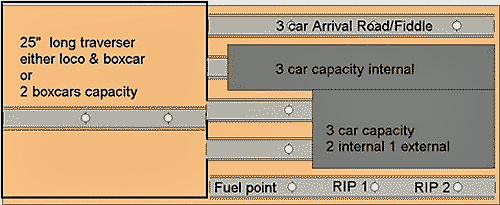
RIP Track Yard
John Garaty, from Unanderra, Australia, focused on an RIP Track yard as a way to represent a lot of activity in a small space. He expanded the idea of Carl Arendt’s Carnegie Car Shops, providing a fully-modeled and prototypical traverser as a way to feed the various repair tracks. Locomotives are repaired along the front track, and the rear (semi-concealed) track is the arrival/fiddle yard area. This little layout provides lots of operation—perhaps drawing cards from a deck could take care of car routing! For more ideas about RIP Track operations, see Scrapbook #30a.
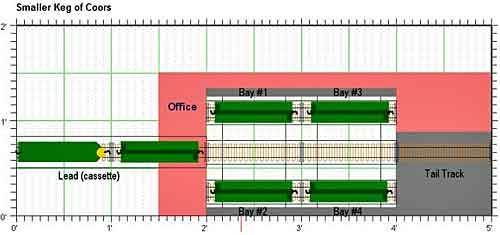
Double Keg of Coors
Dave Ostwald took a different approach. Referring to another layout on this site, Dave suggested modeling a variation of A Keg of Coors. To fit the length, he could use only two shipping spots; but expanding the loading doors to both sides of the drill track could lift the layout’s operations. Claims Dave, “The Transfer tables would have to be independent (three per spot) and operate in the manner that the prototype did, where either of the loading tables ‘pushes’ the (middle) switching table out of the way to align itself with the other switching tracks. As a result the layout is compact, operational, and prototypical.” Wow!

Capstan Switching
Another way to get lots of action in a tiny space is to use capstan switching, where the locomotive pulls a rope snubbed around a post or capstan to haul the wagons into place. This concept started as a sketch by the pseudonymous Puffernutter, and was later taken up by Shortliner Jack Trollope, from the Highlands of Scotland. Jack suggested, “I’d be tempted to add two more capstans (in red) and model the warehouse with the track going into it, with operating opening doors, and actually pull the wagon inside and close the doors while it is being loaded/unloaded. With the extra capstans you can actually pull the wagons onto the turntable and then pull it into the warehouse.
“There would be room on the siding for a second wagon turntable and another capstan and operating doors to do the same thing—all the shunting being done with the loco, capstans, and ropes. Two turntables and doors would allow shunting to continue while the load/unload of the other wagon is being done out of sight behind closed doors—after all, the Boss won’t be happy if his workmen are standing about idle!”
IS THIS THE SMALLEST POSSIBLE MICRO LAYOUT?
Tim Cotter, who lives in Stanley, Falkland Islands, forwarded a news story from the American Institute of Physics. It’s a discussion of “nano-locomotives” that could haul materials around the microscopic nano-factories of the future! The story includes a diagram (below) of what may be the smallest possible micro layout… it’s a nm-scale locomotive moving on a circular track measuring only a few molecules on a side!
The locomotive is made of three tiny clusters of atoms connected by “springs” that are made of photochromopher molecules, whose length can be expanded or shrunk with light. The “track plan” is made of tiny pits in a surface, looking something like a molecular-sized egg crate (but perfectly smooth to the naked eye). When a laser light is bounced off the surface from above, the locomotive expands, then contracts into the next depression on the surface. Voilà! an atomic pizza layout!
Click on the drawing below to be transported into the atom-sized world of Nano Layouts, then click on the video triangle (at lower left) to watch the nano-pizza run!
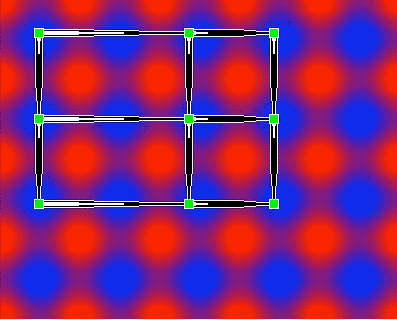
BOX-FILE BRIGADE CONTINUES TO GROW
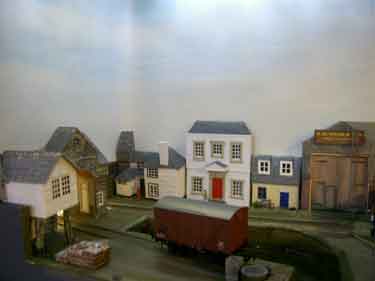
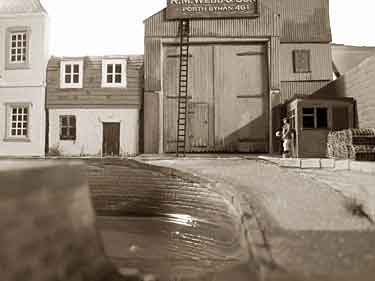
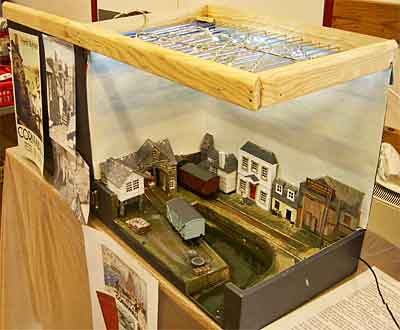
Porth Byhan
Stu Hilton, from Cornwall, England, modelled Porth Byhan as a typical Cornish harbor town, served by a GWR branch railway during the steam era. The catch is that he chose to model it in a box file! [For American readers: a box file is a pressed cardboard box that holds correspondence and other papers on shelves in a British office. They are virtually unknown in the U.S. A typical inside dimension is 330x260x75mm (13×10¼x3in.)]
Stu fabricated the layout base from foamcore board and scratchbuilt all the structures, copying buildings from prototype Cornish harbor towns. Scale is OO (1:76 on 16.5mm gauge). The complete design/construction saga can be viewed on RMweb.
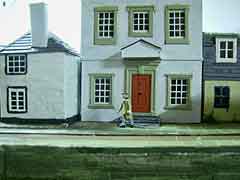
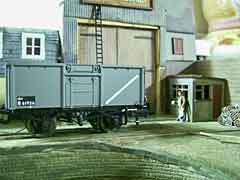
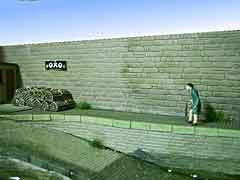
Brereton Heath
Chris Thomas, from Cheshire, England, designed Brereton Heath, his first micro layout, as a UK based modern-image traction maintanence depot. It’s housed in a box file. Chris remarked, “It’s 00 gauge and has been designed primarily for me to house my class 66 locos. Construction took two weeks and the cost was minimal, as the layout was made out of things from previous scrapped projects.”
[Ed. Note: Other examples of layouts built in box files can be found in Scrapbooks #18, #34, #69, #72, and #85a.]
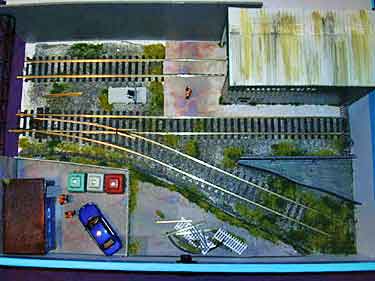
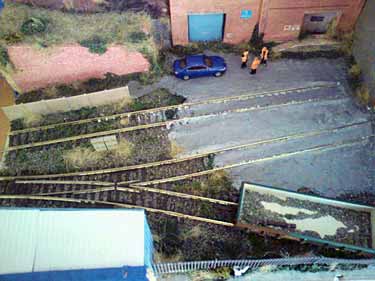
A ‘SJOKOLADEFABRIKK’ MAKES CHOCOLATE IN NORWAY
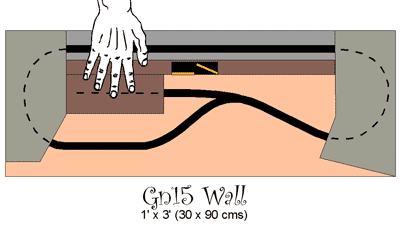
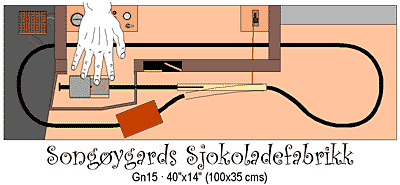
Jon Songøygard, from Arendal, Norway, sent along plans for his latest foray into Gn15 modeling (1:22.5 scale on 16.5mm gauge). After considerable head scratching, he settled on modelling a Chocolate Factory (“Sjokoladefabrikk” in Norwegian), served by a tiny 400mm (15in) gauge railway. The plan is shown at lower left, below Jon’s ideas for scenery on the line.
Laughing, Jon comments, “The brown gates are for light and dark chocolates, I guess! Of course, a few surprises should be expected—rolling stock will be quite whimsical. But I do hope to have found a nice balance here: whimsical rolling stock, solid building mass, large scale.”
We hope to bring you some progress reports as work begins on this nifty layout idea. The editor thinks this layout is a prime candidate for the “aromarama” approach… the smell of the activities adds another dimension of reality to the experience of viewing the layout. Carl Arendt did something similar in his SAP Line, which displayed a maple-sugar production house with smoke strongly scented like maple sugar.
THIS 12-YEAR-OLD’S FIRST LAYOUT IS A GEM
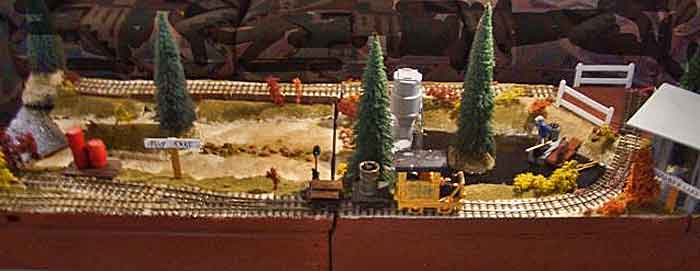
At the age of 12 Jarod Black, from San Diego, California, USA, has built his first model railway, and it’s – as the English would say – a cracker! Measuring 48x16in (120x40mm) the layout is Gn15 scale and features a Schomberg Scale Models “Winky” Brookville switching locomotive.
Jarod calls his railroad the October Lake Hydro-Electric Project. It represents part of the vast system on both sides of California’s Sierra Nevada Mountains that captures the winter snowmelt and funnels it through a series of reservoir lakes to the waiting turbo generators that produce southern California’s electricity. October Lake is part of that chain and sports a small Powerhouse generating plant.
Jarod describes the layout this way: “On the fictional October Lake it is mid autumn and The Edison Company has allowed the lake to drain half way to catch the winter snowmelt in spring. Water is still pouring out of Rush Creek Tunnel [not modeled here] where the water travels from Emerald Lake to October Lake. The water will not stay at October Lake for long, as the pipe under the dam is wide open allowing the water to leave, go through the Powerhouse, and travel to the next lake [July Lake]. A small 15-inch industrial railway serves the dam and The Portal Powerhouse.”
The layout itself includes a sector plate to complete the tight turn around the lake, and features a full-size G scale switch stand from Ozark Miniatures. Jarod produced this charming layout on his own, including purchasing all supplies and the Winky kit from his savings!
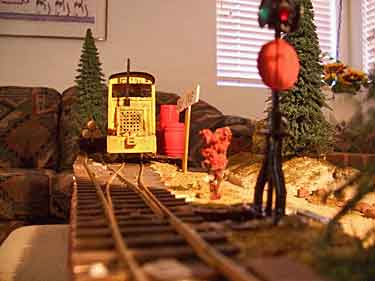
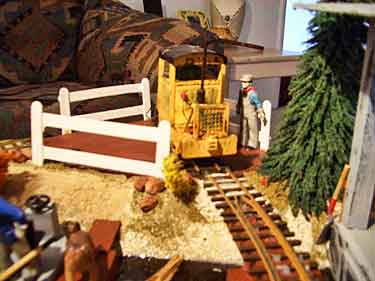
THE SANTA FE ROLLS ON THROUGH COLORADO… IN LUXEMBOURG!
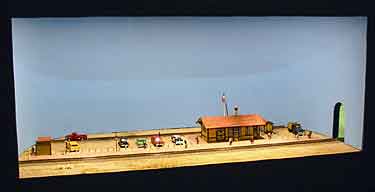
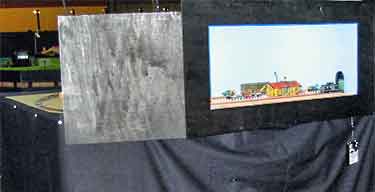
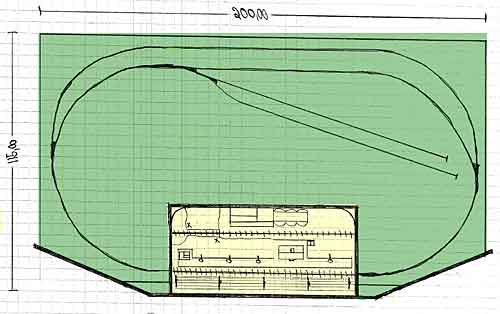
Alain Kap, who lives in Luxembourg, originally built Timpas, Colorado as an 84x40cm (33x16in) display board with a Santa Fe station building, for use in taking pictures of his rolling stock. Then he boxed it in with a background (above left) and a picture-frame proscenium arch, to stage better photographs. But as Alain says, “The [picture frame] box itself is OK for picture taking but a bit boring if only sitting on a shelf!”
So he built an unscenicked oval table layout incorporating the picture frame box (above right) that allowed trains to run through the display scene and even encouraged changing consists of the passing trains (plan at left). The table measures 200x115cm (79x45in). The result, in Alain’s words: “Now I’m able to take [my display] out to shows for the enjoyment of the visitors.”
[Ed. Note: In his email to me, Alain called his display a “shadow box.” This term is often used, usually erroneously, to refer to a layout viewed from one side and surrounded by a picture frame or proscenium arch. Generally, such layouts are not shadow boxes, which are very shallow boxes indeed, with or without frames, designed to hang on a wall and display very small 3D objects like coins or military medals. I usually call layouts that use proscenium arches, “picture frame layouts.” See my article on Theatrical Layout Design for more discussion of this subject.]
THIS N-SCALE COG RAILWAY HANGS ON THE WALL!
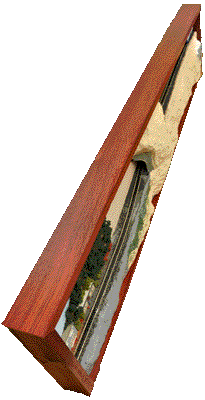
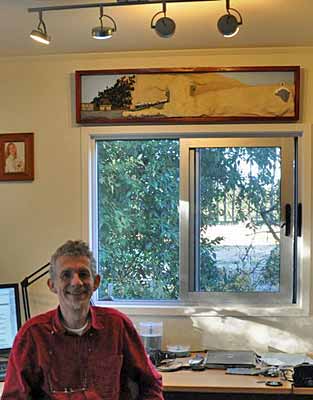
After that lecture about shadow boxes, it’s a pleasure to show you a layout that actually is a shadow box! Jonathan Scott, from Hamilton, New Zealand, built this N-scale cog railway, SprocketBahN, to hang on the wall in his home office (right). It measures 48x11in (120x28cm) and is just 2in (5cm) deep (left) !
Jonathan used Fleischmann track, cogs, and rolling stock, with grades of about 25 percent. (He wanted to make them steeper but the equipment and the required vertical curves in the track made this impossible.) The train is powered by eight AA batteries and controlled by a PIC microcontroller to make a trip every 25 minutes or so. For more, see Jonathan’s website.

You can watch the valiant little train perform by clicking the triangle in the YouTube video below!
Leave a Reply